From the Ant to the Moon :
A survey of collaboration in artists’ books
Overview
My interest in ants begins with how they are represented as a pillar of dedication and work ethic for the hive. Ants have great strength to carry things heavier than themselves, and even larger prizes when several ants join together. There is a strength in numbers and a commitment to the hive, that is sometimes characterized as a “hive-mind” with a negative connotation. If we point a similar perspective at ourselves, scaled down to the ant, the larger creations of mankind are left visible, the cities we’ve built and landscape forever changed. Humans have a desire to be remembered as individuals that is unique to our species, as seen in time capsules, diaries, and the desire to have one’s name “recorded in history.”1 Large scale human collaboration, like the moon landing and the development of cities, has immeasurable impacts to individuals and the greater collective. On a smaller scale, creative collaboration in book arts encourages new ideas to emerge from the push and pull of different voices.
The similarities between humans and nature is depicted throughout the canon of art history, and in the history of artists’ books. Contemporary representations of human nature through the natural lens are found in these works from the collection of the Center for Book Arts. Connection, community, and collaboration are vital to the foundations and growth of the artists’ book genre. Book arts functions within ecosystems of artists, publishers, libraries, collectors and critics. Many of the books selected were created in a collaborative process, and/or with small publishing groups including Martha’s Quarterly, Weproductions, and the Women’s Studio Workshop.
- 1 Jarvis, William E. “Modern Time Capsules: Symbolic Repositories of Civilization.” Libraries & Culture 27, no. 3 (1992): 279–95. http://www.jstor.org/stable/25542451.
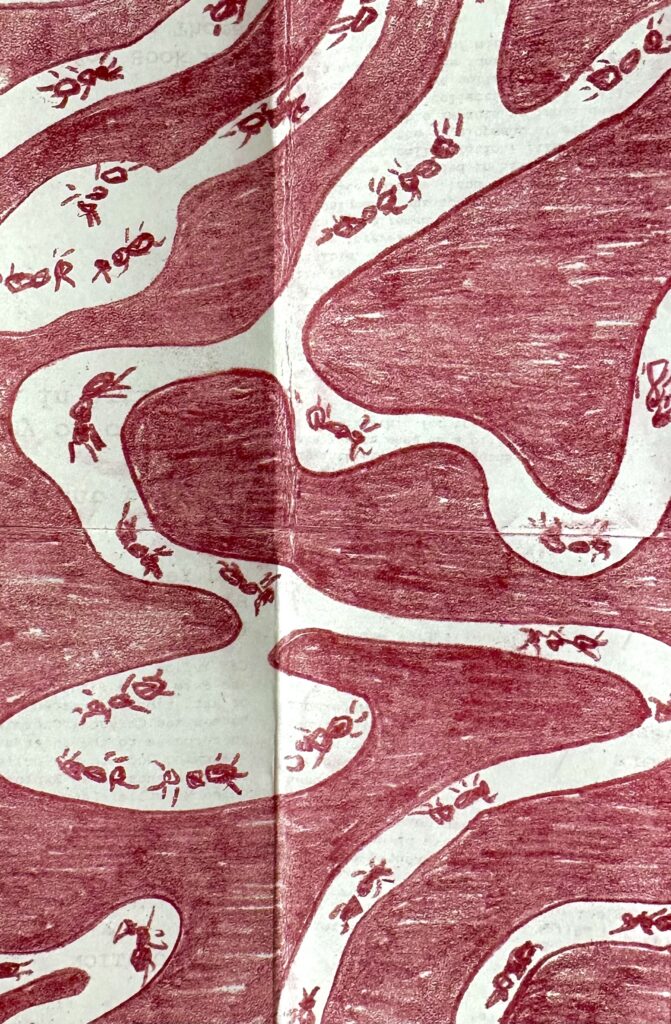
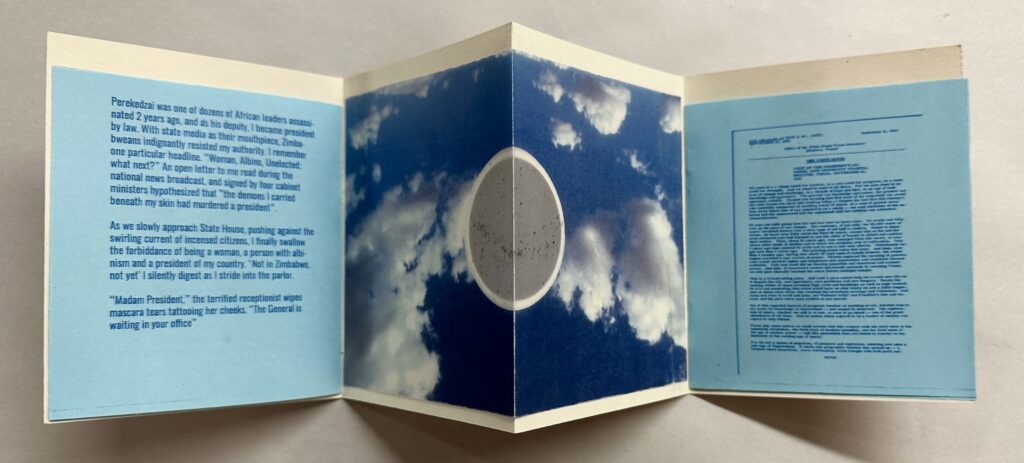
Nguyen, Tammy, Téa Chai Beer, and Katrina Fuller. Martha’s Quarterly, Issue 13, Fall 2019: A Corner for Mankind. Passenger Pigeon Press, 2019.
A Corner for Mankind, by Martha’s Quarterly connects the story of the resilient Wekiu bug, with futurist fiction of otherhood and power struggles, and the real and imagined press of the moon landing.
Central to the zine are illustrations of the Wekiu bug populating a pop-up volcano, Mauna Kea. The Hawaiian volcano Mauna Kea has been the subject of protests, as native Hawaiians have resisted the building of new telescopes, and in a conflict of ‘progress’ over preservation. The Wekiu bug’s fortitude allows it to thrive in an extreme volcanic environment, “feeding off the insects that are carried by the wind to the mountain top to die.”2 Looking through the telescope cutout in the centerfold of the zine, a map of the skies as seen from the southern hemisphere is visible.
The history of space exploration is shrouded in grandiose legacy, the ambition and pride of man to conquer the skies. It relates to a history of imperialism and colonialism, and to collective goals of a population. In one signature is a futurist fiction by Nodumo Ncomanzi, exploring ideas of the “Other” and power, a story where people with albinism gain government control across Africa. Additionally the zine included a speech written by Nixon’s speechwriter, William Safire, prepared for the possibility of “moon disaster”, and John F. Kennedy’s speech that called for the country to be unified in the challenge of the moon.
This zine considers the nuance of progress and sacrifices that are taken to accomplish mankind’s greatest feats. And asks who is left out of a legacy of man united in a singular goal, in the narrative of “we choose to go to the moon,” and “the brotherhood of man.”
2 Tammy Nguyen, “Martha’s Quarterly Issue 13 Fall 2019 A Corner for Mankind,” Passenger Pigeon Press, https://www.passengerpigeonpress.com/marthas-quarterly

McDermott, Sarah. Channel & Flow. Women’s Studio Workshop, 2014.
Channel & Flow was created by Sarah McDermott as an artist in residence at the Women’s Studio Workshop in Rosendale, NY. McDermott illustrates her attempt to follow the path of a stream in Arlington, VA, that has been altered by suburban development. The sense of movement is interrupted and disjointed at times, as the stream has been diverted and constricted.
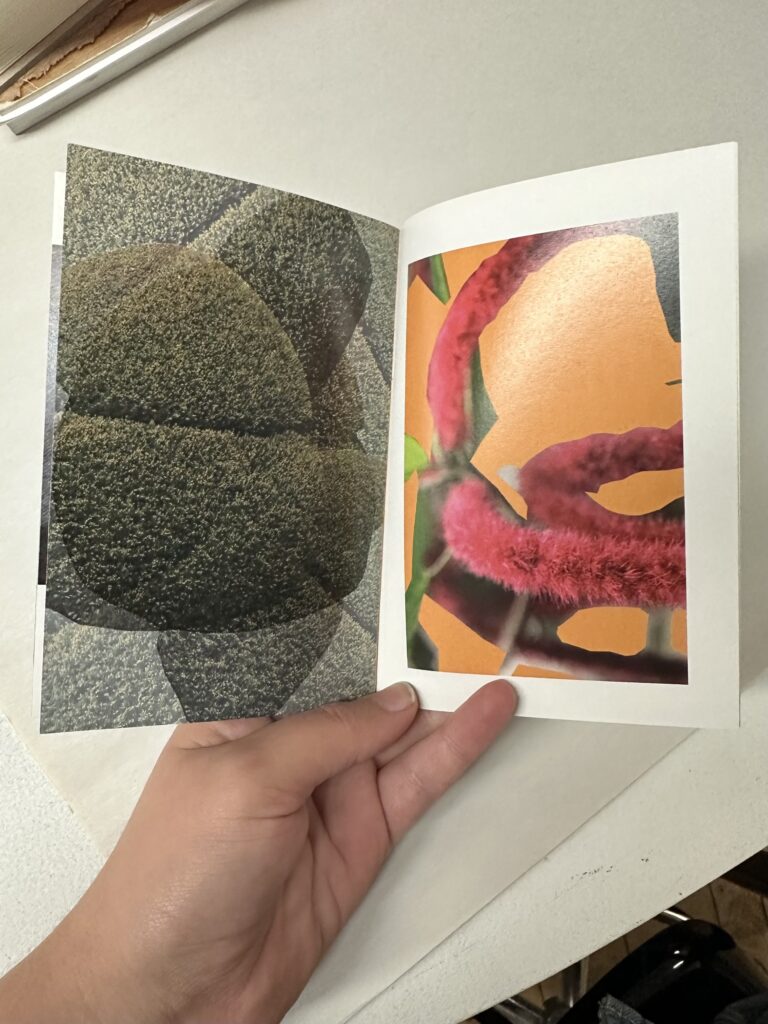


Bodman, Sarah and Chrystal Cherniwchan. Cad Yellow Deep. 2018. FA.B9.2386
Bodman, Sarah and Chrystal Cherniwchan. Red Blue Shades. 2018. FA.B9.2387
Bodman, Sarah and Chrystal Cherniwchan. Perm Green Light. 2018. FA.B9.2388
Cad Yellow Deep, Red Blue Shades, and Perm Green Light are a trilogy of artist books created by Sarah Bodman and Chrystal Cherniwchan, in response to the short story ‘Watching God’ in the collection Three Moments of an Explosion by China Miéville. Language, time, movement, color play through natural elements. This collaborative project blends influences from the story and the artist’s different voices, accented with isolated moments of texture and color.

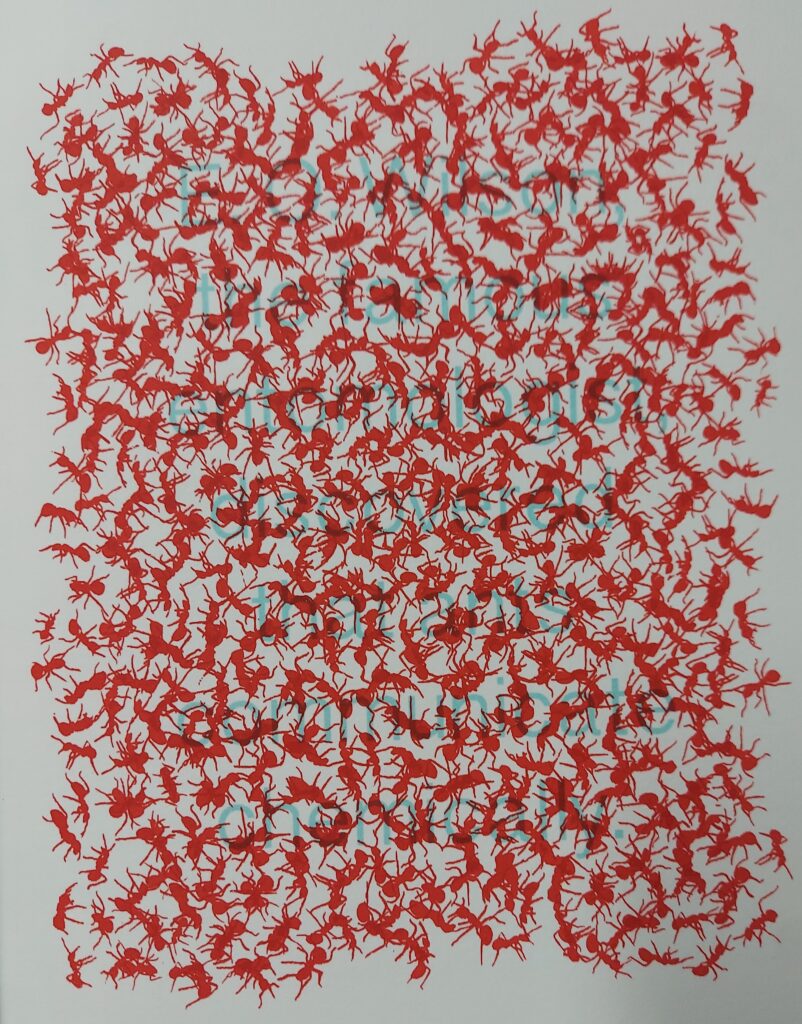
Hicks, Candice. Coincidence. 2014.
Candice Hicks delves into the phenomenon of coincidence in this iteration of her composition notebooks rendered in cloth, a series entitled Common Threads. As Hicks investigates coincidence in her writing, she follows various trails of thought and references to media or memory. Red ants move throughout the pages of the book, sometimes in an orderly line functioning as a margin, or gathering into a swarm, overlaid with text that is revealed with the use of red glasses.
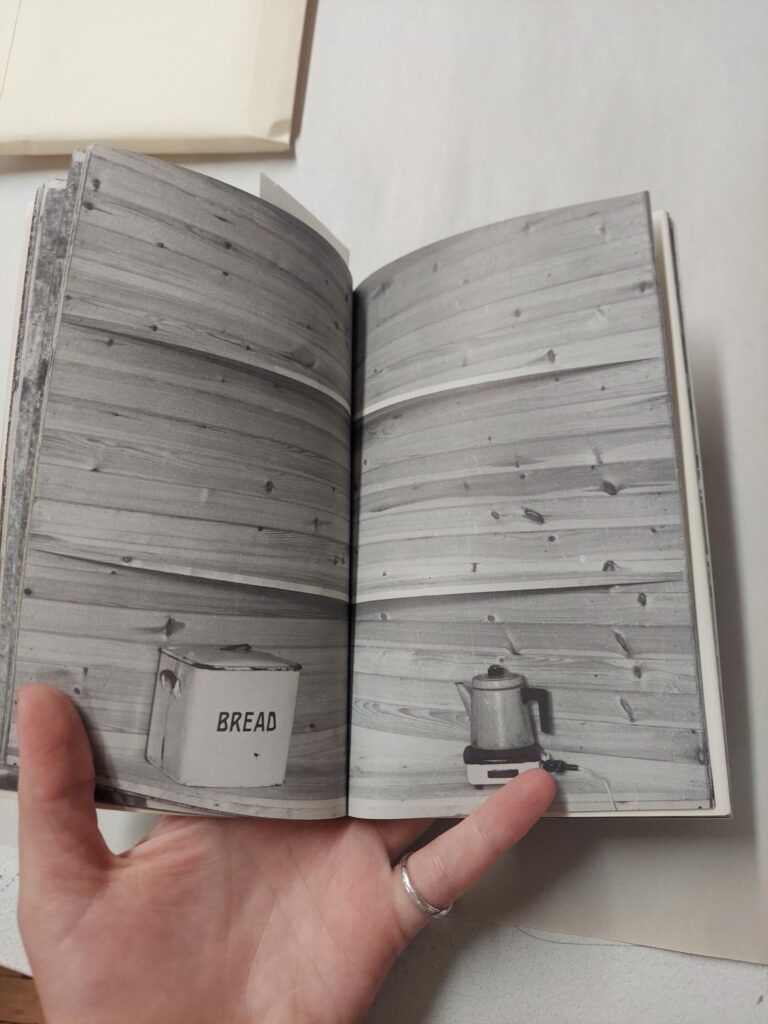
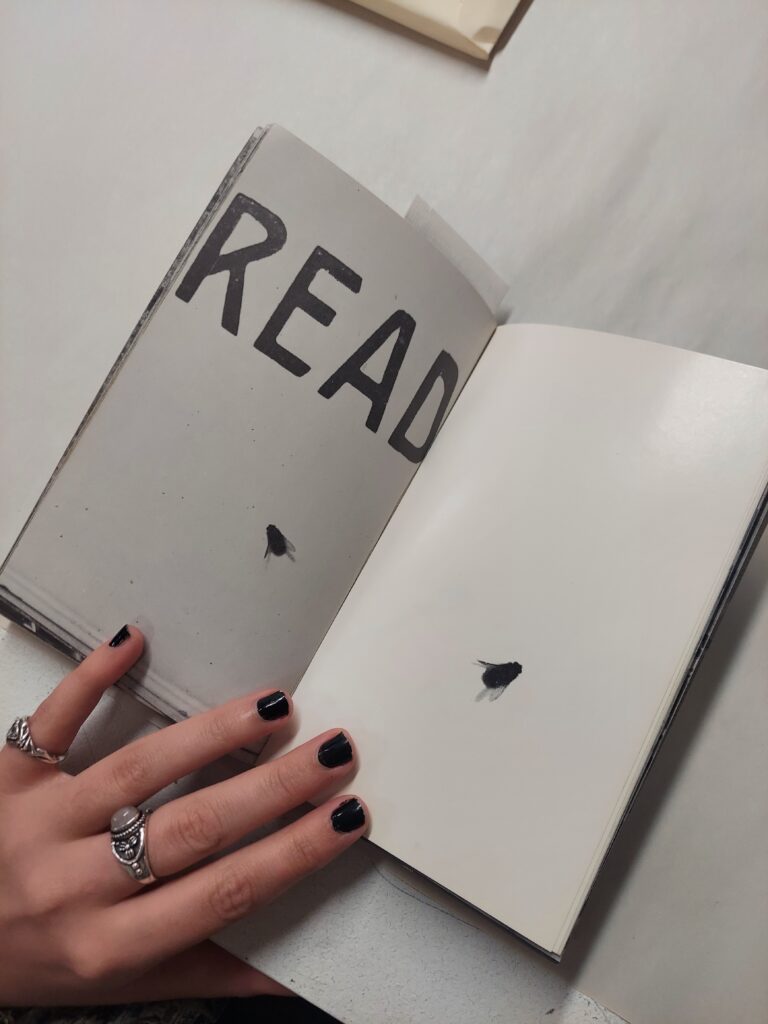
Douglas, Helen and Telfer Stokes. Chinese Whispers. Weproductions, 1976.
Chinese Whispers is a collaborative project of Helen Douglas and Telfer Stokes of Weproductions. The process of its creation relates to its title, which refers to a game of information being passed along and distorted, also known as telephone. A strong point of view that moves us into a space in a rural setting, zooming in and out on specific views and objects, and shifting saturation. The viewer moves though the book in a way that feels predetermined, like a line of ants moving in a set path. There is a sense of narrative as we zoom in and out of a fly on a bread box, or a package of cabbage seeds and cabbage leaves. A piece of sod was cut in the same dimensions as the book, and reproduced in full bleed photographs, with the front cover being the grass, and the back cover being the roots and soil. We enter the book as an unassuming ant moving through the grass, and find an intimacy and familiarity with the objects and spaces in the pages.
Yap, Christine Wong. CO-LABORATION. 2020.
CO-LABORATION is a zine illustrating surveys and interviews conducted by artist Christine Wong Yap, with six artists in New York, San Francisco, and Wichita. The results of which show the perspective of artists on how collaboration and community impact their work.
For more on artists’ books community:
Pichler, Michalis. Publishing Manifestos: An International Anthology From Artists and Writers. MIT Press, 2019.
8 Ball Community, 8 Ball Almanac. 2022.
For more on the natural world in book arts:
Fairman, Elisabeth R. Of Green Leaf, Bird, and Flower : Artists’ Books and the Natural World. Yale University Press, 2014.
Created by Kris Thomas in a Summer 2023 internship with Gillian Lee. The collection is currently on view at the Center for Book Arts alongside the zine of this project.
This collection is located at Center for Book Arts. Researchers wanting more information or to make a research appointment can email collections@centerforbookarts.org or fill out this form.